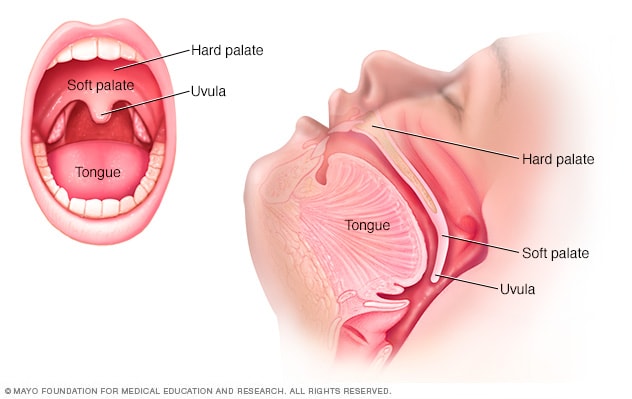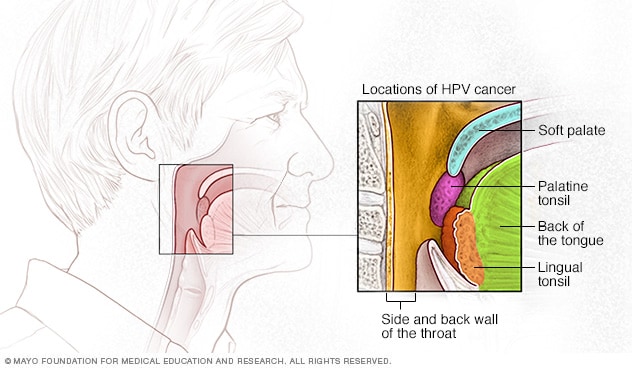Overview
Soft palate

Soft palate
The soft palate is located in the upper portion of the back of the mouth, behind the teeth.
Soft palate cancer is cancer that starts as a growth of cells on the soft palate. The soft palate is located on the upper part of the back of the mouth, behind the teeth.
Soft palate cancer most often begins in the thin, flat cells that line the inside of the mouth and throat, called squamous cells. When cancer starts in these cells it's called squamous cell carcinoma.
Soft palate cancer can cause changes in the look and feel of the tissue on the soft palate. These changes may include a lump or a sore that doesn't heal.
Soft palate cancer is considered a type of throat cancer. It is treated similarly to the way other types of throat cancers are treated. This may include a combination of surgery, radiation therapy and chemotherapy.
Symptoms
Signs and symptoms of soft palate cancer can include the following:
- Bleeding in the mouth.
- Difficulty swallowing.
- Difficulty speaking.
- Bad breath.
- Mouth pain.
- Sores in the mouth that won't heal.
- Loose teeth.
- Pain when swallowing.
- Weight loss.
- Ear pain.
- Swelling in the neck that may hurt.
- White patches in the mouth that won't go away.
When to see a doctor
Make an appointment with a doctor or other healthcare professional if you have any symptoms that worry you.
Causes
HPV and throat cancer

HPV and throat cancer
Human papillomavirus, also called HPV, is a common infection that's passed through sexual contact. It increases the risk of certain types of throat cancer. HPV has been linked to cancer that affects the soft palate, tonsils, back of the tongue, and the side and back wall of the throat.
Soft palate cancer happens when cells on the soft palate develop changes in their DNA. A cell's DNA holds the instructions that tell a cell what to do. In healthy cells, the DNA gives instructions to grow and multiply at a set rate. The instructions tell the cells to die at a set time. In cancer cells, the changes give different instructions. The changes tell the cancer cells to make many more cells quickly. Cancer cells can keep living when healthy cells would die. This causes too many cells.
The cancer cells might form a mass called a tumor. The tumor can grow to invade and destroy healthy body tissue. In time, cancer cells can break away and spread to other parts of the body. When cancer spreads, it's called metastatic cancer.
It's not always clear what causes the DNA changes that lead to soft palate cancer. For some soft palate cancers, human papillomavirus is thought to have a part. HPV is a common virus that's transmitted through sexual contact. For most people, HPV doesn't cause any problems. For others, it causes changes in the cells that may one day lead to cancer.
Risk factors
Things that may increase the risk of soft palate cancer include:
Using tobacco
All forms of tobacco increase the risk of soft palate cancer. This includes cigarettes, cigars, pipes, chewing tobacco and snuff.
Drinking alcohol
Frequent and heavy drinking increases the risk of soft palate cancer. Using alcohol and tobacco together increases the risk even more.
Being exposed to human papillomavirus, also called HPV
HPV is a common virus that's passed through sexual contact. For most people, it causes no problems and goes away on its own. For others, it causes changes in the cells that can lead to many types of cancer, including soft palate cancer.
Having a weakened immune system
If the body's germ-fighting immune system is weakened by medicines or illness, there might be a higher risk of soft palate cancer. People with a weakened immune system include those taking medicines to control the immune system, such as after an organ transplant. Certain medical conditions, such as infection with HIV, also can weaken the immune system.
Prevention
Ways to reduce your risk of soft palate cancer include:
Don't use tobacco
If you don't use tobacco, don't start. If you currently use tobacco of any kind, talk with a healthcare professional about strategies to help you quit.
Limit alcohol intake
If you choose to drink alcohol, do so in moderation. For healthy adults, that means up to one drink a day for women and up to two drinks a day for men.
Ask about the HPV vaccine
Receiving a vaccination to prevent HPV infection may reduce your risk of HPV-related cancers, such as soft palate cancer. Ask your doctor or other healthcare professional whether an HIV vaccine is appropriate for you.
Have regular health and dental exams
During your appointments, your dentist, doctor or other healthcare professional can check your mouth for signs of cancer and precancerous changes.
Oct. 10, 2023